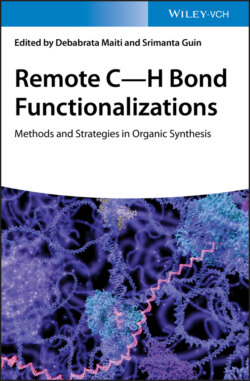Читать книгу Remote C-H Bond Functionalizations - Группа авторов - Страница 15
2.2.2.3 Benzoic Acid Derivatives
ОглавлениеBenzoic acids are highly important structural motifs or precursors for drug molecules or natural products. Efficient diversification of benzoic acid derivatives is significantly desired in drug discovery. Benzoic acids were conventionally functionalized at the meta‐position by electrophilic aromatic substitution under harsh conditions as they are generally deactivated toward electrophilic reactions. Though the meta‐C–H activation strategy using directing templates has been successfully applied to many electron‐rich/neutral arenes, it is generally less effective for electron‐deficient arenes, possibly due to the low reactivity of electron‐deficient arenes toward palladation in this type of reaction. Consequently, transition‐metal‐catalyzed meta‐C–H activation of benzoic acids is considerably challenging. In early 2016, the Li group developed the first effective nosyl protected 2‐cyano‐phenylethylamine directing template that efficiently promoted the meta‐C–H olefination of a broad range of electron‐poor benzoic acid derivatives, regardless of the substitution patterns (Scheme 2.17) [28]. Remarkably, this protocol tolerated challenging highly electron‐deficient tri‐substituted benzoic acid derivatives. Such substitution pattern was not observed in previous transition‐metal catalyzed meta‐C–H functionalizations of (hetero)arenes through known approaches before the disclosure of this work (Scheme 2.17a). This result might imply that a matched directing template is important for meta‐C–H functionalizations of different substrates regardless of electronic property of the substrate. Notably, molecular oxygen that is environmentally benign could be utilized as the terminal oxidant in this protocol. Instead, costly silver salt oxidants were predominantly used in almost all template assisted meta‐C–H olefinations. Moreover, the mono‐/di‐olefination selectivity could be improved by switching the MPAA ligand. For example, a good ratio of mono over di‐olefination could be achieved for the model substrate (44, R = H) by selecting Formyl‐Gly‐OH instead of Ac‐Gly‐OH as the ligand, though the yield was reduced a little bit. Finally, the sulfonamide chelating template, which is now available from Sigma‐Aldrich as the Li–Li auxiliary, could be readily prepared in a large scale and easily cleaved from the product and recycled under very mild basic conditions (Scheme 2.17b).
Scheme 2.17 (a) meta‐C–H olefination of benzoic acids. (b) Removal of directing template.
Source: Modified from Li et al. [28].
Moreover, using the aforementioned nosyl protected 2‐cyano‐phenylethylamine template, Li and coworkers also realized meta‐C–H acetoxylation of electron‐deficient benzoic acid derivatives bearing different substitution patterns (Scheme 2.18) [28]. Remarkably, the directing template could be readily cleaved with concomitant generation of a methyl ester. The methyl ester was then readily converted to a triflate, which could be used for accessing several synthetically useful meta‐functionalized benzoic acid derivatives (Scheme 2.18b).
Scheme 2.18 (a) meta‐C–H acetoxylation of benzoic acids. (b) Elaboration of meta‐functionalized benzoic acid derivatives.
Source: Modified from Li et al. [28].
In 2017, Houk, Yu, and coworkers also reported meta‐C–H olefination of benzoic acid derivatives with a conformationally flexible nitrile‐based template (Scheme 2.19) [29]. Notably, this new template was engineered through joint experimental and computational efforts. It was demonstrated that it was possible to computationally predict meta‐selectivity of the devised templates with reasonable accuracy by using a Boltzmann distribution of all accessible C–H activation transition states. This newly designed optimal template, which favors a silver–palladium heterodimer low barrier transition state, enabled the Pd catalyzed meta‐C–H olefination of benzoic acid derivatives with moderate‐to‐good yields and generally high regioselectivity. Notably, the authors found that kinetic experiments revealed there was a fourfold increase in rate in the presence of MPAA ligand Ac‐Val‐OH. Finally, it was believed that the dialogue between synthetic and computational chemistry groups might inspire the development of novel templates for remote C–H activation.
Scheme 2.19 meta‐C–H olefination of benzoic acid derivatives with conformationally flexible nitrile‐based template.
Source: Modified from Fang et al. [29].
